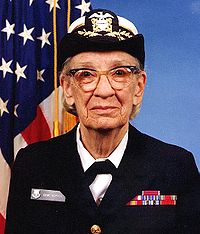May 28, 1959: inventing language for business
 Year 1959: Pentagon meeting gives rise to a computer language that will later become known as COBOL and will be the primary business computing tool for the next 40 years.
Year 1959: Pentagon meeting gives rise to a computer language that will later become known as COBOL and will be the primary business computing tool for the next 40 years. Kobol, short for Common Business-Oriented Language, was one of the first computer languages. And, along with Fortran, it was one of the first programming languages based on English vocabulary.
Kobol owes its existence to Grace Hopper , one of the first computer programmers. Grace took her first programming steps in the US Navy reserve, typing machine code for a Harvard Mark I computerduring the second world war. In the late 1950s, she came to the conclusion that computer languages could be made similar to the human language, and thus more understandable than the assembler and machine code used then.
Sensing a successful alignment to create a more accessible and useful programming language for business, in 1959 the Pentagon assembled several working committees. Among them were representatives of various computer manufacturers, so that this language would not depend on the iron component. The most productive of the committees quickly wrote the initial language specification, using Flow-Matic as a starting point, diluting it with ideas borrowed from IBM's business-oriented language, Comtran.
By December 1959, the committee had completed work on a language specification and named it COBOL. The first Kobol compilers appeared extremely quickly - already in 1960. The language underwent changes and in 1968 passed the specification of the American National Standards Institute. Kobol seemed attractive to business application developers because of its readability, accessibility and simplicity, with which it could be used to calculate business functions. By 1997, according to the Gartner Group, 80 percent of enterprises use Kobol, and the total length of the source code for all Kobol applications is 200 billion lines.
This legacy turned into a monstrous burden when IT administrators made the belated discovery that the Kobol language design encouraged programmers to store year data in only two digits. This prompted fear of potential system failures with the advent of 2000, because, for example, the software would suddenly start reporting the age of someone born in 1959 as -59 years (00-59 = -59), and not 41 ( 2000-1959 = 41) year. Suddenly, thousands of retired programmers at Kobol were returned to work if they plowed the old code and updated the programs, ensuring their capacity after 2000.
Although most of these programs survived the 2000 problemKobol’s business was not going so well. It should be noted that it continues to be used in many places, especially on old mainframes and minicomputers. Graduate Butch, an expert programmer , told Wired magazine in 2003 that "even the old Kobol system can take root on the web by managing a new site."
Now Kobol is no longer a field for active research and scientific work. No one goes to college planning to learn the Kobol language, and you will most likely be kicked out of your IT department if you offer to implement the next project in this programming language. An attempt by individuals to upgrade and update Kobol standards was made in the early 2000s, but this group has not updated their website since 2005.
For all intents and purposes, Kobol is less and less suitable. But its existence stimulated the development of many other high-level programming languages that use quasi-English syntax (from BASIC to PHP) and made it possible to study programming to a wider mass than before. This trend, we hope, will never go out of style.
Source: Wired.com
